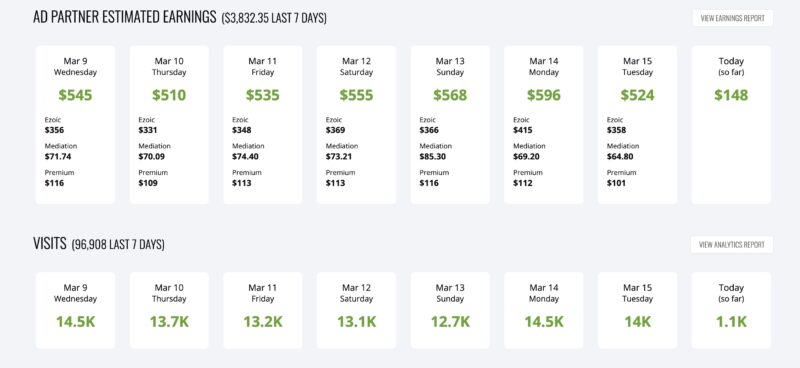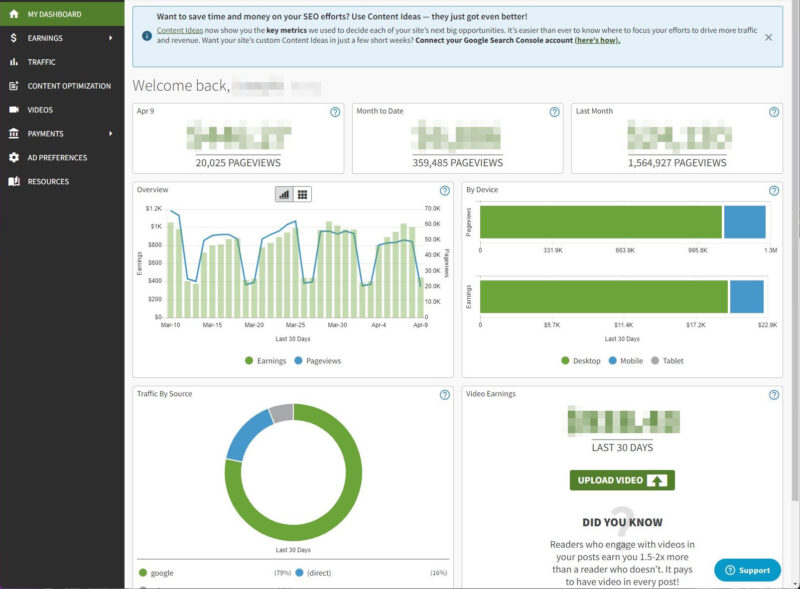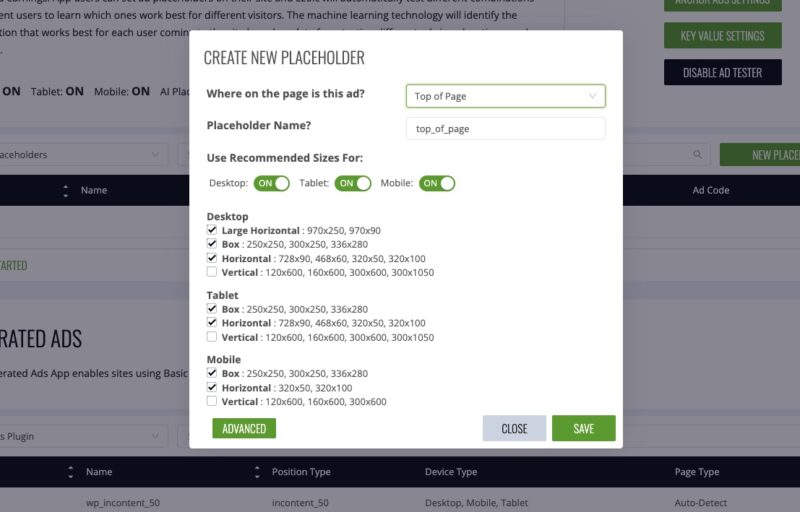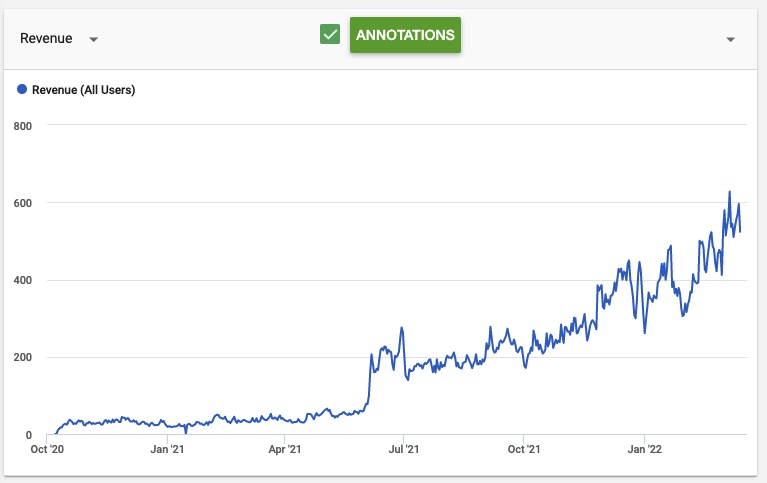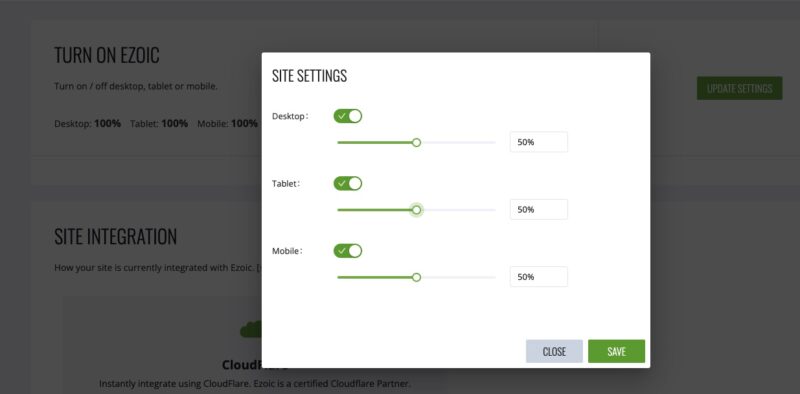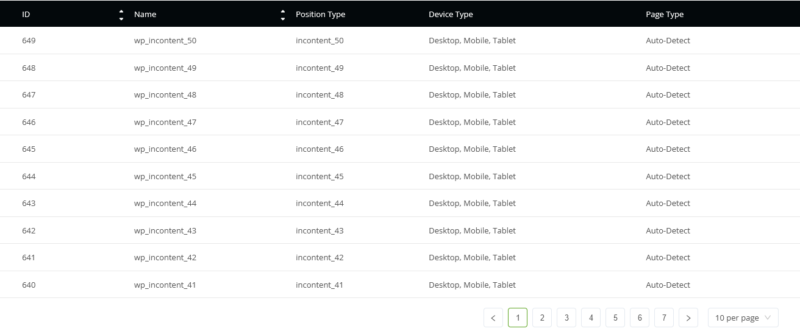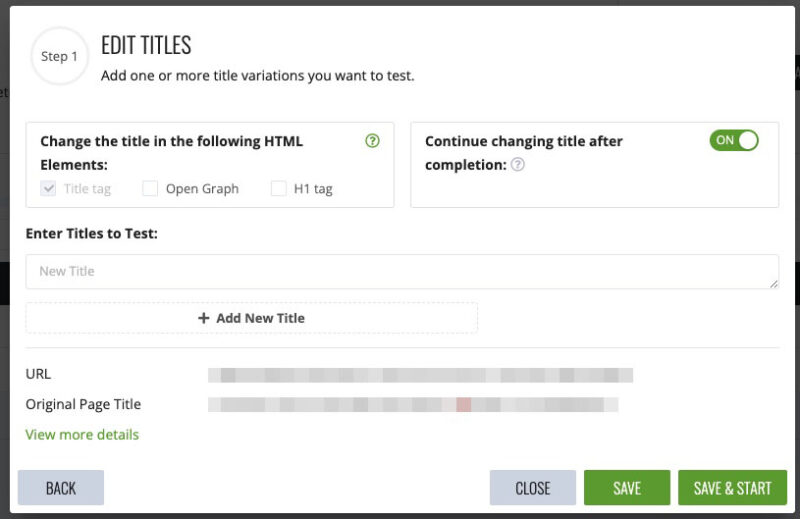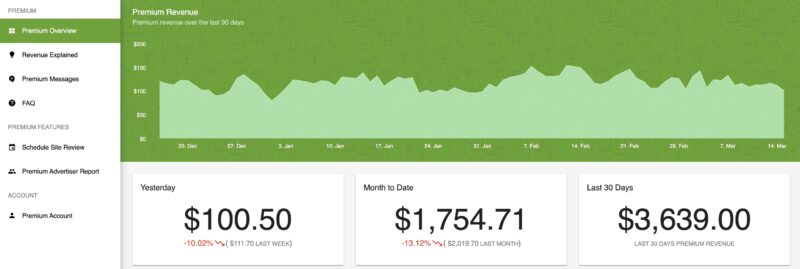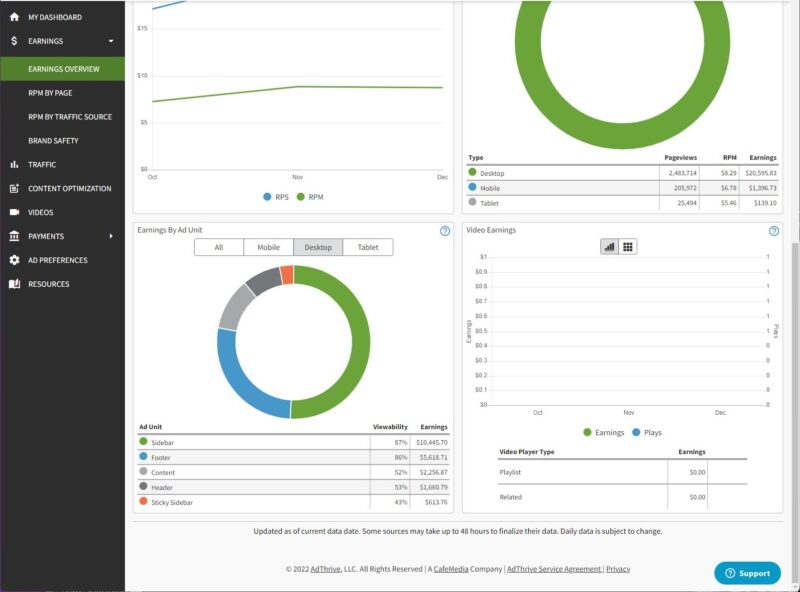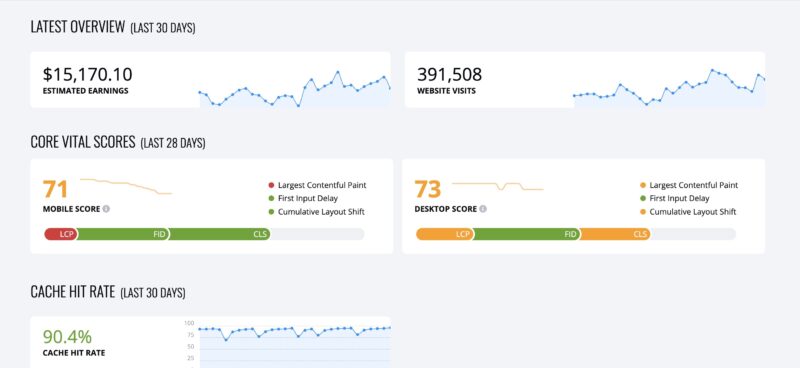When it comes to monetizing online content, one of the toughest challenges is picking out who you’d opt for as your go-to ad provider. Naturally, this isn’t as easy as it might appear, since every provider has their distinct specialties, not to mention a varying set of pros and cons. Some perform better than others if you care about ad revenue and long-term growth. So, how about Ezoic vs AdThrive?
Comparing Ezoic vs AdThrive is a clash of titans, representing two behemoths among the ad provider community. When putting them side-by-side, Ezoic vs AdThrive could handily outperform more entry-level solutions like Google’s AdSense. All the while, they each offer unique solutions, technologies, as well as management solutions for optimizing and maximizing your site’s ad earnings.
They have distinct services and technologies to help publishers fine-tune ads on their webpage, and eke out as much ad revenues as possible. All the while, aiding to boost engagement and interaction from your audience. From our own experiences, Ezoic has out-earned AdSense across the board. But how about AdThrive? Could Ezoic stand a chance when looking at Ezoic vs AdThrive?
- What Are They?
- Minimum Requirements
- User Experience
- Ad Revenues
- Pricing And Fees
- Miscellaneous
- Final Thoughts
- FAQs
What Is Ezoic Vs AdThrive, And What Do They Do?
We’ll go in-depth when comparing Ezoic vs AdThrive in just a moment. But for now, let’s take a step back and understand more about these two. So, who is Ezoic, and who is AdThrive? For the unaware, they’re both premium ad network providers. By signing up with them and integrating your site with their servers, you’re allowing them to display advertising to monetize your content.
Whether you’re a small blog or a large news publication, platforms like Ezoic and AdThrive allow you to collect a steady stream of ad revenue. If you’re already familiar with Google’s AdSense, comparing Ezoic vs AdThrive is somewhat similar. The key difference is that Ezoic and AdThrive are premium and advanced solutions. Both of whom, in fact, claim to offer high ad revenues.
From our standpoint, we’ve proven this to be true, after migrating from AdSense to Ezoic. Thus far, it has gained us (and others) handsome ad earnings, much higher than AdSense. It does so thanks to its use of artificial intelligence and machine learning. Through that clever computation, Ezoic features a set of tools where they’d dynamically alter how ads are shown to maximize ad revenues.
Meanwhile, we have AdThrive, which also features the same end goal of making the most out of ad earnings. In a way, AdThrive is quite similar to Mediavine, in that its platform offers a catered and tailored approach. Unlike the highly detailed nature of Ezoic, AdThrive’s schtick revolves around its team of data scientists, analysts, and marketers taking the wheel to optimize your ads.
What Are The Minimum Requirements For Ezoic Vs AdThrive?
To begin looking into Ezoic vs AdThrive, we’ll start by checking to make sure that your site is eligible for joining their ad network in the first place. Every ad provider has a set of minimum requirements that decide whether or not you could monetize with their platform. Usually, the most basic form of threshold to meet is traffic. After all, some ad providers work best with larger publishers.
Many ad providers set the qualifications based on how many monthly visits/sessions/pageviews you have on your site. For example, your publication needs to have 10,000 monthly pageviews before you can begin monetizing with some ad providers. Ezoic vs AdThrive has a barrier of entry, but it’s made quite apparent that Ezoic is more beginner-friendly and approachable compared to AdThrive.
This table below (with further explainers beneath that) shows in greater detail the minimum requirements for both Ezoic vs AdThrive. We could see here that AdThrive’s overly high and specific criterion for application really only makes it suitable for larger or well-established publishers. Hence, you might have to resort to competing ad solutions beforehand:
| Minimum Requirements – Ezoic Vs AdThrive | ||
|---|---|---|
| Ezoic | AdThrive | |
| Monthly Traffic | None (at least 1,000 monthly pageviews is recommended for optimal monetization) | 100,000 monthly pageviews minimum |
| Compliance With Google Ad Policies | Yes | Yes |
| Post Quality And Engaging Content | Yes | Yes |
| Content Type, Genre, Or Niche | Anything (other than any content that’s been flagged as illegal, questionable, or adult in nature) | Preferably lifestyle-related content (such as tech, food, travel, culture, pets, home, DIY, sports, etc.) |
| Preferred Regional Traffic | Anywhere in the world (no geographic traffic preferences) | Majority US (US-borne traffic has to rank #1 for your site), UK, Canada, Australia, or New Zealand |
| Review And Integration Time | Between 12 to 24 hours to get an approval (with another 3 to 5 hours later for site integration and setting things up) | Around 1 week to get approval (with slightly less hassle in the way of integrating your site) |
A) Ezoic Minimum Requirements
Not too long ago, Ezoic had set a minimum threshold of 10,000 monthly pageviews if you wanted to monetize your site with them. Even compared to most leading ad providers, this was quite low, and was just above AdSense’s no set traffic requirement. However, this soon changed.
As of an update posted in June of 2021, Ezoic began accepting sites with fewer than 10,000 monthly pageviews for monetization with their platform. This was achieved with their Access Now program, which has been catered to smaller publishers with fewer than 10,000 monthly pageviews.
Overall, this initiative meant that tinier and upstart sites could leverage the same tools, services, as well as perks, and technologies that larger publications usually get. Extending this even further, this provides small publications a fantastic chance to kickstart earning higher ad revenues early on.
Thus, helping them to rapidly accelerate growth from an early stage. Therefore, it doesn’t matter if you’re an up-and-coming blogsite with a few thousand visits. Or, perhaps a massive publication with millions of followers around the world, as you could both monetize with Ezoic’s network.
1. Other Requirements To Join Ezoic
Ezoic does have other requirements and criteria to be met before you can start monetizing with its network. In short, your site must:
- Pull in at least 1,000 monthly pageviews before joining Ezoic. To be clear, this isn’t a requirement. Rather, it’s a recommendation by Ezoic (alongside having your domain live and publishing content regularly for some months). This way, you can be certain that you’ll attain optimal results.
- Prove that it’s pulling in traffic. You could use services like Google Analytics to understand how much traffic your site is gaining. Prior to joining Ezoic, you should ideally have a healthy volume of visits or pageviews on your site. Better still, seeing that traffic is steadily growing around your content.
- Contain content that’s unique and engaging. Your content could be written around any subject or niche, as Ezoic could monetize a wide variety of genres. However, your content has to at least be of good quality, and isn’t massively plagiarised or is basically a copy-and-paste of another site.
- Be in compliance with Google’s advertising policy, given that Ezoic sources its ads from Google’s ad marketplace. In other words, your site can’t feature any content that explicitly violates copyright rules. In addition, this extends to sites that contain inappropriate content like illegal or adult topics.
B) AdThrive Minimum Requirements
Whereby Ezoic is easily accessible for smaller or newcomer publishers, AdThrive has steep barriers to entry. In a sense, they’re not feasible for many publishers as a first-time ad provider, so you’d have to resort to relying on its competition (like Ezoic) for some time while your site is growing.
Only after you’ve pulled in significant traffic, could you perhaps consider upgrading over to AdThrive. Whether or not it’s worth the upgrade over solutions like Ezoic, is something that we’ll uncover later. For the time being, we can relegate AdThrive as one of the more premium ad providers.
Its most basic requirements say that your site has to be pulling in at least 100,000 pageviews every single month. Even for us, our now-burgeoning case study domain took some time to gain this much traffic. This is especially out of reach for most websites, even established ones.
Moreover, AdThrive requires that your site’s traffic comes from certain parts of the world. These are regions where the ad markets are competitive and lucrative enough to justify serving through their network. As such, you’ll also have to consider where your traffic is coming in from.
1. Other Requirements To Join AdThrive
To clarify further our point, and to add on top of that, here are a few more requirements that your site has to meet before monetizing with AdThrive. Your site must:
- Feature a majority of traffic to be borne from the US, UK, Canada, Australia, or New Zealand. Once again, the online advertising market in these regions is of higher quality and high-paying enough for AdThrive’s business. In return, AdThrive can serve your site more premium ads.
- Have content that’s unique, quality, original, and engaging. AdThrive is more focused on sites that create content around lifestyle-related niches. These include topics such as tech, food, travel, culture, pets, home, DIY, sports, and so on. Genres beyond these are acceptable, as well.
- Comply with Google’s ad policies, and haven’t had any issues with other ad providers in the past. In particular, your site must have a good standing and no prior problems with AdSense. If your site was denied monetization in the past for any reason, it might prejudice your application with AdThrive.
- Be secured with HTTPS, and your site must also feature an SSL certificate. If your site is still secured with the old HTTP standard, AdThrive has a right to reject your application. This is to ensure that data regarding your site and how it’s integrated with AdThrive is kept secure.
How About The User Experience Between Ezoic Vs AdThrive?
Another critical criterion for choosing either Ezoic vs AdThrive is how their ads impact your site’s user experience, respectively. The simplest rule to maximizing your site’s earnings and ad revenue is with putting as many ads on a page as possible. Once every square inch is covered, this high volume of ads ensures that your users and audience have no choice but to view or interact with them.
While this might boost your ad revenues significantly, this does adversely impact the user experience. Having to scroll past too many ads will assuredly annoy and alienate your audience, prompting them to abandon your site en masse. Moreover, embedding too many ads onto a site also slows down page load times. This won’t just be detrimental to your visitors’ experience, but it could also rank you poorly.
Google’s search algorithms punish sites with poor load times and bad user experiences. Therefore, what techniques do Ezoic and AdThrive have to enhance the time your readers spend on your site? If this table (and more explainers below) are anything to go by, it does seem that AdThrive has a slight upper hand in optimizing the user experience. Although, Ezoic isn’t too far behind:
| User Experience – Ezoic Vs AdThrive | ||
|---|---|---|
| Ezoic | AdThrive | |
| Automated Ad Management | Yes (thanks to their AI and machine learning-powered Ad Tester tool that dynamically adjusts and optimizes a page’s ad layout, while continually tweaking it periodically) | Yes (owing to their tailored and hands-off approach, they have a team of data scientists, analysts, engineers, and marketers to try and design the most optimal ad layout for your site) |
| Ease Of Setting Up And Integration | It will take some time and effort, as the integration process requires configuring each setting manually, but Ezoic will calibrate all of this on the fly once your inputs are in place | It won’t be as challenging, as most of the site integration, initial set-up, and configuring of your preferences are all managed by AdThrive, so you needn’t have to do much |
| Granular Controls And Configurability | Yes (Ezoic gives you a lot of options and configurability for you to choose from and play around with, and lets you take full control of how ads appear on your site) | Not Much (most of the things that you need to control and modulate are done by AdThrive and their ad optimization team, leaving you with few options and configurability) |
| Focus On Performance And Core Web Vitals | Yes (they have handy tools and software like Leap and their cloud-based CDNs to enhance your site’s page load times, performance, and Core Web Vitals scores) | Yes (thanks to its robust and future-proof ad code to ensure reliable data analysis, and extensive expertise with JavaScript alongside the inclusion of performance-enhancing plugins) |
A) Ezoic User Experience Enhancements
One of Ezoic’s most unique traits, especially in comparing Ezoic vs AdThrive, is its way of including AI and machine learning. Once you’ve integrated your site, the first step towards monetization is to try and create ad placeholders. This can be automated via the WordPress plugin.
Placeholders are essentially dedicated spots on your page where ads will appear in. For those wondering how many placeholders you should make, the answer is a lot. In our case, our case study domain with its high-word count pages required us to set up lots of placeholders. Roughly one every 5 paragraphs.
To make things easier, Ezoic has some plugins and a Chrome extension where you could embed the placeholders and tweak them. Ezoic themselves recommend that you include as many placeholders that a page could feasibly fit. Each one varies in placement, sizing, density, and the type of ads.
There’s a good reason for Ezoic’s “nothing is too many” approach, as this then goes through their AI computation. Those placeholders that you spent a lot of time setting up won’t necessarily show ads. In fact, Ezoic treats that template as a sort of suggestion for their clever Ad Tester tool.
With the power of AI, it would then automatically test thousands or millions of combinations to find the most ideal layout. For instance, Ad Tester may enlarge some of your placeholders, or move them to other parts of the page where it thinks is a better location. You get quite a lot of control, too.
You may, for example, optimize the ad layout for a better user experience (fewer ads, and placed in parts of a page that are less distracting). Or, for maximal monetization (more ads, in as many places as possible). Once that’s up and running, Ezoic’s machine learning will make adjustments.
Over time, it’ll analyze how your audience interacts and engage with those ads. With that data, their machine learning computation will calibrate the ad layout further, and tailor them for each visitor. Aside from that, Ezoic has other tricks up its sleeve to optimize the user experience:
1. Ad Tester – Automated AI-Powered Ad Layout Testing
Speaking of, we should discuss a bit more on Ezoic’s AI and machine learning ad layout optimization tools that we highlighted beforehand. Unlike Mediavine or AdThrive, Ezoic gives publishers plenty of control and input over how to best display ads, feeding into Ezoic’s AI and machine learning.
With your template in mind, Ezoic would automate fine-tuning the actual layout and re-calibrate it down the line to best optimize the appearance of ads. Ultimately, Ezoic’s Ad Tester can dynamically change how ads show up on your site and vary in their:
- Placement – What parts of your webpage do ads appear at? Could this be on the header, footer, side margins, between paragraphs, or after an image? Ad Tester does so to maximize attention from your site’s visitors. But, without having to distract them too much (depending on your settings).
- Density – How many ads would appear on a single page at a time? Ezoic could display as many as 100 ads at once, but ideally around 20 or so would be sufficient. The more ads you have, the higher your earnings would be. However, Ezoic will tailor this density further based on your users’ behavior.
- Sizing – How big should each ad banner be? There is a myriad of sizing options between small, medium, or large banners. You could pick their orientation, portrait, or landscape. And, set them for each device (mobile, desktop, or tablet browsers). Big placeholders have a better chance of gaining attention.
- Type – What type of ads would show up for each individual banner? Do you want to display native ads, anchor ads, sidebar ads, and so on? Differing types of ads might entice different people, and might get a varying interaction or attraction from your audience, depending on what it might advertise.
It should be noted that Ad Tester doesn’t deliver optimal results instantly. The AI as well as machine learning will account for numerous variables to fine-tune the layout further. This might take up to 12 or so weeks, as it’ll find out the optimal template for showing ads to maximize your ad revenue.
2. Leap Optimization – Speed Up Your Site’s Load Times
Optimizing ad layouts isn’t the only tool that Ezoic offers, mind you. Among the plethora of services that you get access to when signing up include Leap. This is a tool devised to optimize your site’s performance and ensure that publishers attain the best Core Web Vitals scores.
The latter could significantly give you insight into how bad or good your site’s user experience is. It’s simply down to how folks might be discouraged from spending time or interacting with a site that loads too slowly or is sluggish to use. Thus, impacting future traffic leading to your site.
In addition, search engines like Google also take Core Web Vitals into account with their algorithms. A site with poor optimization scoring might rank lower in the search results, further impacting traffic. Ezoic’s Leap could prevent this by periodically analyzing your site’s load times and performance.
It could then diagnose and offer quick troubleshooting options to speed things up. For example, it’ll highlight any unnecessary scripts or plugins that are slowing your site down. You could then make any changes necessary to fix them. Or, allow Leap to make site-wide changes with a quick toggle.
3. Ezoic CDN & Caching – Reliable And Fast Caching
While we’re on the subject of performance, we also have to note the importance of where your site is hosted. Ezoic offers you the ability to cache all your content on its cloud-based CDNs for faster loading times.
This has the benefit of upping your Core Web Vitals scores even further. Seeing how your users don’t have to wait for eons before a page is loaded, it’s a boon for the user experience. Additionally, faster load times and higher Core Web Vitals scores are viewed more favorably by search engines.
Google’s algorithms might rank your site higher in search results, giving you better visibility to gain more traffic and maximium ad revenues. Besides that, there’s an argument to be made that hosting your site on Ezoic’s cloud CDNs could save you money with their performance optimizers.
Ezoic could point out any plugins, scripts, or software that you otherwise could do without. On top of that, there are security and privacy upsides for publishers, too. Ezoic’s CDNs feature improved DDoS protection, bot protection, finding click fraud, and preventing spammy ads from showing up.
B) AdThrive User Experience Enhancements
In stark contrast to Ezoic, AdThrive’s method for managing ads is more hands-off, as they provide a somewhat tailored approach. Once you’re ready to start monetizing with them, you’ll be discussing closely with AdThrive’s ad optimization team. They’ll then make all the adjustments for you.
AdThrive would fine-tune how they design the ad layout for your page based on specific goals. You might want to hit an ad revenue target, or you might want a specific template for ads to appear. In doing so, AdThrive’s team will alter the ad layout to meet your preferences, backed up by data.
They have data scientists, analysts, engineers, and marketers to help understand and improve your site’s ad layout. This is unlike Ezoic, where you’ll mostly have to make these alterations yourself with the help of their AI and machine learning computation, though they do have publisher success managers to assist with these tasks.
Therefore, AdThrive is much more suitable for someone that has no interest in ad placements optimisation. Elsewhere, the user experience you could argue is slightly smoother with AdThrive than it is with Ezoic, with fewer ad intrusions. This is thanks to how AdThrive is set up out of the box.
Their focus has always primarily been on improved usability, performance, and site load times. To achieve this, we’ve documented how AdThrive typically displays fewer ads per page compared to Ezoic. It makes sense that with fewer ads to load, your site’s loading times would increase.
Although, this might somewhat compromise ad revenues, as we’ll explore later. With AdThrive’s ability to best balance out user experience with earnings, they’re able to achieve this through the use of their proprietary solutions and techniques, such as:
1. Performance Plugins – Elevate Core Web Vitals Scoring
A key part of AdThrive’s promise to smoothen out your browsing experience is through the use of its performance plugins. This can help to streamline the back-end processing of your site, ensuring that page loading times are kept to a minimum. Plus, AdThrive has extensive expertise with JavaScript.
Their tech and optimization teams are more than happy to work alongside you to up the performance of your website even further. Consequently, you’ll notice a healthy boost in your Core Web Vitals. It comes with decreased bounce rates among your site’s visitors, with better on-page interaction.
2. Identity Solution – Future-Proofed Ad Code
Ad code integration can be quite fickle, as changes in how browsers collect and store cookies could be detrimental to your site’s monetization. Additionally, it’ll impact just how well your ad provider, such as AdThrive, could analyze and gauge your site visitors’ behavior to meet their tailored model.
This means that AdThrive can’t effectively adjust the ad layout based on data, leading to a poor user experience. Not to mention, declining ad revenues and a lack of engagement. This won’t be the case now, thanks to their inclusion of a robust and future-proof ad code to combat that.
How Much Could Ezoic Vs AdThrive Earn You With Ad Revenues?
If there’s one thing more important than optimizing your site’s user experience, it’s measuring how’d they work with maximizing your site’s ad revenue. When comparing Ezoic vs AdThrive, this is among the most consequential deal-breakers for deciding who to go for. One thing’s for sure, they’re much better than Google’s AdSense, which is one good reason why you’d opt for premium ad providers.
Platforms like Ezoic, Mediavine, or AdThrive offer a variety of high-specialized technologies and tools to help publishers maximize their returns from ads. It’s for that reason why we left AdSense for dead and migrated over to Ezoic a while back. With our case study domain, within a month of making the switch (not even the full 30 days), we were earning 3.5x as much with Ezoic than with AdSense.
Nowadays, our daily ad earnings every 24 hours from Ezoic are 3x higher compared to what AdSense would’ve paid us across an entire month. This is thanks to Ezoic’s uber-smart AI and machine learning having optimized the ad layout on our site down to a T. That alone was sufficient to eke out far nicer returns than AdSense. On the other hand, AdThrive has its own way to help maximize your yields.
For publishers, they have entire teams of people working at analyzing data across your entire site. It then enables those same people to discuss and make tweaks to how ads are delivered on your site. In the end, you get higher ad revenues. To compare, here’s a breakdown of the average RPM (revenue per thousand) across 4 popular ad providers, courtesy of Income School’s extensive research:
| Ad Networks Revenue Comparison (Adjusted For ~50,000 Monthly Sessions) | ||||
|---|---|---|---|---|
| AdSense | Ezoic | Mediavine | AdThrive | |
| Minimum RPM | $8.00 | $14.00 | $12.41 | $4.79 |
| Maximum RPM | $28.59 | $31.74 | $47.00 | $37.00 |
| Mean RPM | $18.30 | $23.48 | $25.42 | $22.70 |
| Median RPM | $18.30 | $25.00 | $24.30 | $23.06 |
A) Ezoic Ad Revenues
When it comes to monetization, there are a lot of variables to consider. In other words, how much we earned in ad revenue when comparing Ezoic vs AdThrive might not be reflective of yours. Perhaps, you have netted higher returns using AdThrive instead of Ezoic, owing to the underlying factors.
Primarily, we have to look at what niche or genre of content you’re creating. In addition, you have to analyze where the majority of your site’s traffic comes from. Certain niches earn more than others. In concert, certain regions of the world have more lucrative ad markets, impacting your ad revenues.
With all that in mind, we still found that Ezoic generally out-performed AdThrive, and it’s very similar to what that table above is showing. The winning factor here is Ezoic’s AI and machine learning, as it aims to prioritize ad revenues over catering to the smoothest possible user experience.
That is especially so once you consider subscribing to their Premium program. Here, you’ll get access to top-tier, premium advertisers, which guarantees increasing your site’s ad revenue even further. It should also be reminded that Ezoic’s AI and machine learning takes some time to take effect.
As we mentioned earlier, this could take upwards of 12 or so weeks, as AI and machine learning figure out the optimal ad layout. Once that period is over, you could begin to see ever-increasing ad revenues. Across the board, it handily wins out against AdThrive for sheer ad earnings.
Throughout a diverse array of niches, Ezoic can monetize them more consistently. In contrast, ads from AdThrive only work best with lifestyle-based content. Furthermore, while AdThrive can only monetize certain regions effectively, Ezoic can maximize earnings across an international audience.
Moreover, Ezoic has some other neat tricks for helping to maximize earnings for your site:
1. Split-Testing – Monetise With Two Ad Platforms At Once
But what if you can’t choose between either Ezoic vs AdThrive? Or, you may want to put them to the test, head-to-head, first? In that case, Ezoic has its neat split-testing tool. Using this, you can throttle your site’s traffic, and allow your site to be monetized with two ad providers at the same time.
For example, you can monetize 50% of your site with Ezoic and the other 50% with AdThrive. This is a good way to test them both and see which one works best under the same conditions. This feature is also able to let you split-test separately based on the browser (mobile, desktop, or tablet).
2. Mediation – Earn With Google (If They Pay More)
While Ezoic often yields the highest ad revenues, that’s not always a guarantee. Some other networks may pay more for a specific ad spot, for example. To make sure you’re not losing out, Ezoic has its mediation tools, which track the bidding data for specific ad spots and analyses them.
Let’s say Ezoic finds out that AdSense could earn you more (i.e. Google was the higher bidder) for an ad spot. If that’s so, Ezoic’s mediation tool would swap out those ads for Google’s in real-time. When combined with header bidding mediation, it’s a win-win, as Ezoic will always earn you the most it can, whether or not they profit from it.
3. Machine Learning And AI – Automated Ad Management
We may sound like a broken record right now, but Ezoic’s use of AI and machine learning is nothing short of extraordinary. Granted, you might be getting somewhat subpar results (compared to AdThrive) for the first few weeks. However, your ad revenues will start pouring in once it kicks in.
From there, Ezoic’s AI and machine learning computation will continually make on-the-fly changes to the ad layout. It does so in the name of making sure your audience could more readily engage, notice, or even interact with those ads. Albeit, the user experience might be slightly impacted.
4. Tag Tester – Better SEO And Title Optimization
Other than trying to optimize your site’s ads, Ezoic also has services such as Tag Tester, which can guide you on how to optimize your contents title tags.
In short, you can A/B test your title tags and see what pulls in more traffic from organic search.
5. Video Player – Host Your Videos On Ezoic
There’s nothing better than adding videos to supplement your written content and help to provide a boost to your reader’s engagement rate. Traditionally, and if you wanted to make your own videos, you’ll have to go through Google. This means uploading and hosting your videos on YouTube.
Nonetheless, as we noted thus far, Google’s AdSense (which is how you monetize YouTube videos) doesn’t pay you as much as competing ad providers. In that event, why not upload and host your videos on Ezoic’s hosting services, instead. Plus, you could even put Ezoic’s ads on top of it.
B) AdThrive’s Ad Revenues
Thus far, we’ve concluded that Ezoic could earn you more as far as ad revenues are concerned. So, is that it then, or does AdThrive stand a chance to win you over? In actuality, AdThrive certainly has its benefits, and could sometimes, in certain situations, net you higher ad revenues. So, what gives?
Once again, we have to look at our two variables – content niche, and regional traffic. Ezoic is much more consistent and uniform with its oft-high monetization rates across a wide variety of genres. On the other hand, AdThrive works best with content written around lifestyle-related topics.
These include food, home, DIY, culture, pets, sports, travel, and fitness, among others. We observed that content outside of these niches, while they could still earn you handsomely, falls behind that of Ezoic.
Besides the content itself, we have to look at where your site’s traffic predominantly comes from. A key requirement for monetizing with AdThrive is that your traffic has to mostly come from the US, Canada, UK, Australia, or New Zealand. These regions typically have high-paying ad markets.
This is especially the case with the US. If your site is pulling in traffic from these regions, you might earn more from ads. However, international traffic (i.e. your site is pulling in most of its traffic from Asia, for example) isn’t as well-monetized with AdThrive compared to Ezoic’s international focus.
The final consideration is AdThrive’s maximal focus on the user experience. Such a bias means that AdThrive tends to show fewer ad placeholders compared to Ezoic. While AdThrive could monetize more than just fine with fewer ads, it does knee-cap its ability to net you high returns like Ezoic.
Thankfully, AdThrive has other handy techniques to maximize your ad revenues:
1. Video Player – Monetise Your Videos With AdThrive
Just like Ezoic, AdThrive is keen on capitalizing on the growing market for online media. This is pretty handy if you’ve been monetizing with YouTube all this time, and aren’t enthused with the AdSense returns. Do you have a large collection of old videos, or are you planning to create new ones?
Well, then why not host them on AdThrive, instead? The hosting itself is free (as with Ezoic), and you could have AdThrive ads running on top of it. Alongside your written content, this should give you a neat way to create a secondary revenue stream, by capturing ad earnings from your videos.
2. Premium Ad Campaigns – High-Earning Advertisers
One upside that platforms like AdThrive offer are their close partnerships and exclusivity deals with their advertisers. In particular, signing up with AdThrive means that your site is automatically rolled into some of the top advertising campaigns running on AdThrive’s network.
You also get exclusive access to national brand campaigns, which could also yield you much higher earnings. Therefore, there’s a good reason to believe that with certain seasons, or if there are any special events going on with partnered brands, you could profit handsomely with AdThrive.
3. Lifestyle Content – Earn More In This Niche
If you’re a lifestyle-focused publisher, it’s worth checking out AdThrive. Alongside other providers like Mediavine, AdThrive is one of the most popular lifestyle-based ad providers out there. Specifically, its community and pool of publishers write mostly about food, home, parenting, DIY, or even finance.
We mentioned that Ezoic’s model of generally accepting every niche does mean that they’re far more consistent, no matter what your content is.
How Do Pricing And Fees Compare In Ezoic vs AdThrive?
Regardless, choosing between either Ezoic vs AdThrive all comes down to this – how much would they cost you to use? When it comes to ad providers, they usually abide by a revenue-sharing model for all their services rendered. This means that out of your total ad revenues, the ad providers get a small cut for your use of their platform. The same goes with Ezoic vs AdThrive, and how you’d pay them.
Looking at these two, it’s apparent that Ezoic is much cheaper to subscribe to. Ezoic has a revenue-sharing model, as well. They take a 10% cut of ad revenues through their platform. Note, this 10% is only cut from Ezoic-sourced ads, and doesn’t take into account mediation or split-testing. Earnings from other ad providers are 100% untouched.
With the low barrier of entry and relatively low cost, this makes Ezoic a fantastic pick for the smaller publishers among you. Or, you could opt to pay more for its Premium program, for access to higher quality premium ads that’ll earn you more. Yet, Ezoic has consistently earned us more in ad revenue. This is very tantalizing given that Ezoic offers an abundance of add-on tools and services for free.
Albeit, specialty tools like their site speed accelerator does have a price attached. All in all, a pretty great deal, when you consider that Ezoic throws in other perks and incentives. For example, you can apply for their revenue guarantee initiative. Here, they’ll promise that you’ll earn at least 25% more than its rivals (like AdThrive) within 30 days. Or, Ezoic will pay the difference (and 25% on top of that).
Breaking Down The Pricing, Fees, And Payment Between Ezoic Vs AdThrive
So, how does AdThrive fare? Well, their cost is certainly more expensive, and if you’re not writing any lifestyle-focused content, it’s hard to justify the expense. Specifically, AdThrive also features a revenue share model. Compared to Ezoic, AdThrive’s cut of your site’s total ad revenues is a high 25%. In other words, you get 75%, while AdThrive takes the other 25%. There are no other options, it seems.
In fact, you could see in real-time within your AdThrive dashboard to note how much you’re already paying to AdThrive. The amount you see on the main dashboard page is 100% yours, as AdThrive has already deducted its cut of the deal. Nevertheless, we have to consider that AdThrive works with the top advertisers in the world, so their higher fees do make sense. It’s up to you to think if that’s fair.
In addition, we have a more thorough breakdown of the pricing, fees, as well as some notes on the withdrawal and payment options for Ezoic vs AdThrive:
| Pricing And Payments – Ezoic Vs AdThrive | ||
|---|---|---|
| Ezoic | AdThrive | |
| Fees (Revenue Share) | Yes (10% revenue share, which doesn’t account for mediation or split-testing) | Yes (25% flat revenue share, with no other pricing options) |
| Ad Revenue Payment/Withdrawal Options | Cheque, PayPal, Direct Deposit, International Wire Transfer (Payoneer), and Payoneer Prepaid Card | Direct Deposit (ACH), Local Bank Transfer, International Wire Transfer, PayPal, Cheque, and Wise/Payoneer |
| Payment Schedule | 30 days (that’s 30 days after the end of the month; e.g. your January ad revenues will be paid by the end of February) | 45 days (that’s 45 days after the end of the month; e.g. your January ad revenues will be paid by the middle of March) |
| Payment Timeframe | Between the 27th and 31st | On the 15th (it might arrive earlier if the 15th falls on a weekend or holiday) |
| Minimum Withdrawal Threshold | $20 (for all payment options) | $25 (for all payment options aside from a wire transfer, which requires a minimum balance of $100) |
Some Other Miscellaneous Comparisons Of Ezoic Vs AdThrive
| Miscellaneous Factors For Comparison – Ezoic Vs AdThrive | ||
|---|---|---|
| Ezoic | AdThrive | |
| Do They Provide In-Depth Data Analytics? | Yes, their Big Data Analytics page offers you a wide array of insights and details than most analytics other tools, such as your site traffic, real-time data, revenue, user behavior, and a lot more | Minimal, as their analytics tools mostly give you basic data on earnings, pageviews, bounce rates, time spent on your website, source of the traffic, and a few others |
| Is Their Customer And Technical Support Good? | Fast and responsive support channels via email or even video calling, with options for problem-solving and long-term planning with an Account Manager, or one-on-one insights and getting suggestions from a Publisher Success Manager (this accessible for larger publications) | Your only primary support line is by sending support tickets (though they do respond very quickly), although you don’t get a dedicated account manager, so most of your tickets will likely be handled by different people with less insight into your platform |
| How Easy Is It To Integrate Your Site With Them? | Simple Cloudflare integration. Step by step sign up guide. East ad placeholder creation using the WordPress plugin and chrome extension. | Much easier compared to Ezoic, as most of the integration is fairly simple and effortless, and much of the back-end setup procedures are usually handled by AdThrive’s tech and support team, making the migration process pretty easy |
Final Thoughts In Comparing Ezoic Vs AdThrive
So then, how can we conclude our guide on Ezoic vs AdThrive, and who would we recommend? It’s an easy choice for us any day of the week, as we’ve been more than pleased with our time on Ezoic. The combination of a low barrier of entry, approachability, reasonable fees, and the uber-high ad revenues you get at the end makes it a fantastic deal. That’s not even accounting for all the extra goodies.
Combined with financial incentives, a high monetization rate, a great way to balance out your website’s user experience, and impressive support staff are the cherry on top. It’s amazing how Ezoic’s capable of netting these gargantuan ad earnings at every turn across the board, with minimal downside. This is all thanks in no small part to its clever integration of artificial intelligence and machine learning.
But don’t just take our word for it, as we’ve written about time and time again, seeing our ad revenues rocket into new highs. This doesn’t mean, however, that AdThrive has been kicked to the curb. We’re impressed with how easy they are to use, and how seamless the integration process can be. That’s not to mention the hands-off approach of letting them take care of everything to optimize your site.
This is on top of their experience in building a smooth and engaging user experience for your site. One significant hurdle is its high qualification requirements. This makes them rather inaccessible to small or upstart publishers. But if you do meet their threshold and write predominantly around lifestyle-type content, they’re certainly worth a try. Although, our money’s still firmly on Ezoic.
FAQs On Ezoic Vs AdThrive
If you have some lingering questions or are unsure, here are some of the most popular questions and answers on Ezoic vs AdThrive…
What Is AdThrive
Just like Ezoic or Mediavine, AdThrive is one of the top premium ad network providers in the world. Their USP is a bespoke content and ad optimization engine to analyze and understand how ads are affecting your site’s monetization and user experience. Additionally, they have a large team of data scientists, engineers, programmers, analysts, and marketers who will help to design an ad layout to tailor fit your audience. All in all, promising higher engagement and ad revenues.
How Does AdThrive Work
In contrast to Ezoic’s model of allowing AI and machine learning computation to optimize ads on your site, AdThrive has a more old-school approach. As your site keeps growing, AdThrive’s own machine learning and computation will analyze your site’s performance. In particular, it’ll look at traffic, and how folks have been interacting or engaging with their ads. Supporting this is a large team of data scientists, analysts, engineers, marketers, and programmers that’ll work together to use this insight. Then, continually tweak and optimize the ad layout on your page on your behalf.
How Many Page Views For AdThrive
Unlike most of its competition such as Ezoic or even Mediavine, AdThrive is only suited for large sites. This is owing to their incredibly high and very specific minimum requirements for your site to qualify. It includes looking at traffic. Here, AdThrive has set a barrier of entry of 100,000 monthly pageviews just to have your site monetized with them. If you’re just starting out, we’d highly recommend looking at Ezoic. Their Access Now plan even caters to publishers with fewer than 10,000 monthly pageviews.
How Many Google Sessions Do You Need For AdThrive
AdThrive is a highly exclusive and premium ad networking solution, which is quite tough to access for smaller publishers. One of their minimum requirements to qualify for monetizing with their ads is that you need to have at least 100,000 monthly pageviews. This equates to roughly 80,000 sessions every month, which is a pretty high bar to reach for most publications. If you need an ad provider, consider Ezoic, and its Access Now program for publishers with fewer than 10,000 monthly pageviews.
AdThrive How Long To Get Approved
Once you’ve submitted your application to have your site monetized with AdThrive, they’ll have to do some reviewing to make sure you qualify. This usually takes around 1 week, but it might take longer if they’re busy. Or, if your site has something that requires further checking. For the most part, the folks at AdThrive will screen your content to make sure that it doesn’t contain any illegal, objectionable, or adult content. These will violate their advertising policies and can get your approval rejected.
How Many Visitors Per Month For AdThrive
While most ad providers are working hard to make their sites more accessible to tinier publishers, this isn’t the case with AdThrive. They’re pretty tough to get into, as your site needs to attract more than 100,000 monthly pageviews. This is just to merely qualify to have your publication monetized through their ad network. If you’re an upstart publication looking at monetization options, we’d recommend looking at Ezoic. With their Access Now program, you can join in, even if you have fewer than 10,000 monthly pageviews.
How Much Does AdThrive Pay
As with every other ad provider, the amount that AdThrive ends up paying will be dependent on your site’s traffic. In essence, the more folks visit your site, the more people there are that’ll view, interact, and engage with the ads on your site. This is how you increase your publication’s ad revenue as time goes on, by focusing on attracting more traffic. In general, AdThrive pays more than most (but not as much as Ezoic), with a return of around $20 to $50 for every 1,000 pageviews.
What Is Normal RPM For AdThrive
RPM is a standard form of measurement for ad revenues, which translates to ‘revenue per thousand’. In other words, that’s how much you’re earning from ads for every 1,000 visitors to your site. RPMs on AdThrive varies significantly based on how much traffic you’re pulling. In addition, it’ll also differ with the content you’re writing or the niche that it covers. Usually, AdThrive’s typical RPM for most sites is around $20 to $50 for every 1,000 pageviews.
How Much Can You Earn With AdThrive
There’s never an upper limit to how much you could earn with AdThrive (or any other ad provider). It all comes down to how much traffic your site is pulling. The more people you can bring to your site, the higher the ad revenues will be. Typically, we’ve found that for every 1,000 pageviews, you can be earning somewhere in the neighborhood of $20 to $50. Once you’ve figured out the right strategy to keep growing your content, that’ll only keep going up.
How Much Money Does AdThrive Pay Compared To Mediavine
AdThrive and Mediavine are some of the top premium ad network providers today. Both of them are actively preaching their respective solutions, technologies, tricks, and strategies to try and boost your site’s ad revenues. However, there are differences in their approach, which leads to differing returns for either one. Generally speaking, we’ve found that AdThrive slightly out-earns Mediavine on most occasions. Although, if you’re looking for ways to maximize your ad revenues even further, be sure to take a close look at Ezoic. In comparison, Ezoic often pays out more than the other two.
What Does AdThrive Not Allow
Every ad provider has a set of criteria for what sites do and don’t get to show their ads. These terms and services could either get your application or existing plan with AdThrive thrown out if you’re not careful. Usually, this encompasses publications that post low-quality content. Or, sites that feature illegal, questionable, or objectionable content. If so, AdThrive is in the right to not show any of their ads on your site until you make certain changes.
How To Speed Up AdThrive Ads
AdThrive’s focus on tailoring for an optimal user experience does give them the upper hand when it comes to site performance. Or to put it another way, how fast your site loads up, and whether or not browsing around your site is sluggish. Slow-loading sites can be harmful to your site’s growth, as it’ll encourage your audience to search elsewhere. The best method of ensuring that your website loads faster is by including an intentional delay for the ads to show up. Usually, around 7 to 8 seconds is a good timeframe. This allows the rest of the site to load up first and take priority before the ads then show up one by one later.
How Does AdThrive Pay
When you’re ready to make a withdrawal of your ad revenues, AdThrive does have several options. A popular one would be a direct deposit or perhaps opt for a wire or local bank transfer. You can have cheques mailed over to you. Or, consider online payment channels like Wise or Payoneer. Just be wary that you need to have a minimum balance of $25 in your account (or $100 or wire transfers).
How Much Does AdThrive Cost
In concert with most other ad providers, AdThrive charges for its services with a revenue-sharing plan. Meanwhile, AdThrive puts in place a 25-75 split. Therefore, their cut of the deal is 25% of all your ad revenues, while the other 75% is yours to keep. Again, this is higher than Ezoic’s 10% revenue sharing model.
Who Are AdThrive Competitors
AdThrive currently competes very strongly in the premium ad network market. Some of their closest and toughest competitors include Mediavine, which also focuses on lifestyle-based content. And, this list also encompasses Ezoic, one of the top ad providers out there. In our experience, and while they each have respective pros and cons, Ezoic is certainly the best of the bunch. Through the use of clever AI and machine learning, Ezoic could handily maximize your ad revenues to out-earn the rest.



